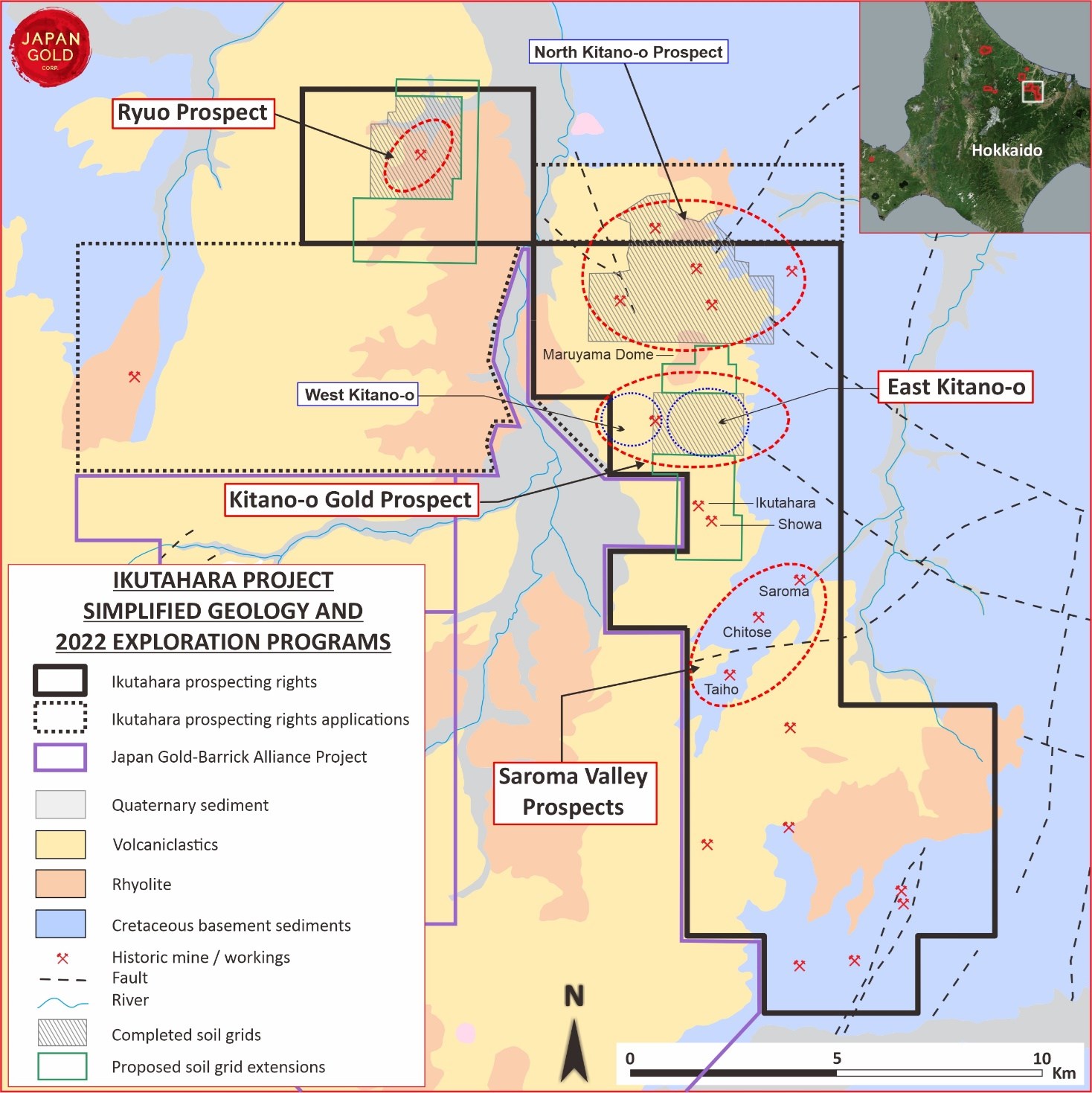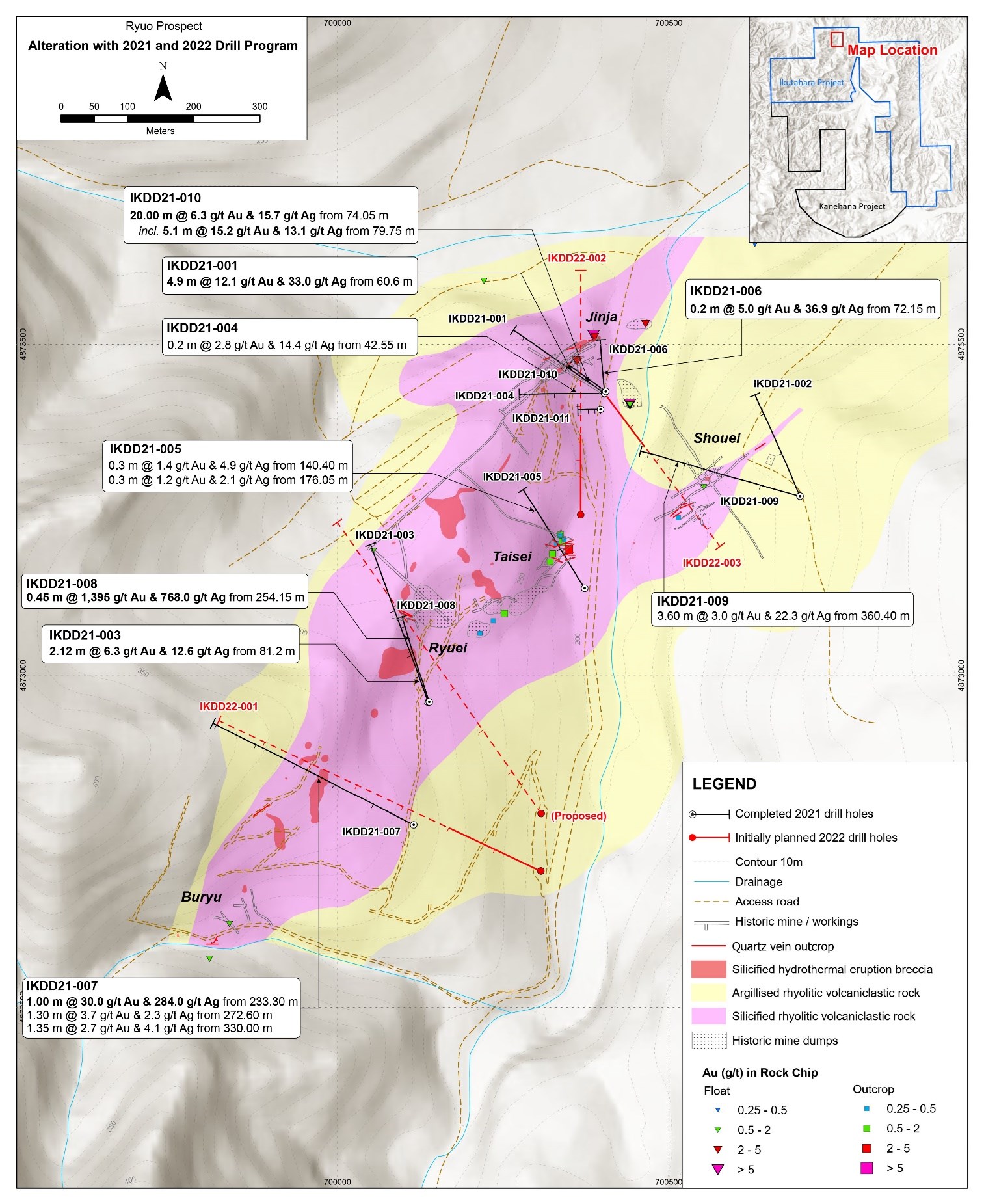Ryuo Prospect Drilling Underway
Japan Gold Commences its 2022 Exploration Programs in Hokkaido
Vancouver, British Columbia--(Newsfile Corp. - May 5, 2022) - Japan Gold Corp. (TSXV: JG) (OTCQB: JGLDF) ("Japan Gold" or the "Company") is pleased to announce the commencement of 2022 exploration programs with the start of drilling at the Ryuo prospect, located within the 100% owned Ikutahara Project in Hokkaido, Japan.
Highlights:
Ryuo Prospect
- All four Company owned and operated drill rigs have been mobilized to the Ryuo prospect with three rigs currently drilling and the fourth drill in place to allow flexibility in targeting options and to minimize down-time between drill holes.
- Eight initial 2022 drill holes, approximately 3,500 m of diamond drill core, are underway at Ryuo to test continuity of high-grade intersections encountered in the 11-hole 2021 drill program and to advance exploration on multiple targets along the 1.2 km long open-ended alteration corridor.
- Drilling at the Jinja vein is targeting continuity of wide high-grade vein intercepts including drill hole IKDD21-010 which intersected 20.0 m @ 6.3 g/t Au & 15.7 g/t Ag, and IKDD21-001 which intersected 4.9 m @ 12.1 g/t Au & 33.0 g/t Ag.
- Drilling at the Ryuei and Buryu breccia zones, located 500 m and 800 m southwest of Jinja, is targeting depth extensions of ultra-high-grades intersected in 2021including 0.45 m @ 1,395 g/t Au & 768 g/t Ag, and 1.0 m @ 30 g/t Au & 284 g/t Ag from drill holes IKDD21-008 and IKDD21-007. These mineralized quartz veins are hosted in an extensive gold-anomalous eruption-breccia inferred to represent the top of the epithermal system, below which wider epithermal veins may be developed in the feeder structure of the breccia.
- Drilling will also target the shallower elevations of a wide, blind vein-stockwork zone intersected along a 29 m length in the bottom of drill hole IKDD21-009 between the Jinja and Shouei veins. This broad vein zone, anomalous in gold along its length, included an interval of 3.6 m @ 3.0 g/t Au & 23.3 g/t. It is inferred that the shallower elevations of this structure may carry higher gold grades.
Upon completion of the Ryuo program, drilling will shift to the Kitano-o and Saroma prospects where an additional 7 drill holes comprising approximately 3,500 m of drilling are planned.
Kitano-o Prospect
- Three initial deep scout drill holes will target the depth extension of coincident geochemical and geophysical anomalies to locate the deeper source of gold mined historically from the Kitano-o placer.
- Surface programs completed on the eastern side of the Kitano-o prospect show elevated gold and pathfinder element geochemistry in soil and rock supported by CSAMT resistivity anomalies which lie proximal to major graben bounding faults.
- More than 96,000 ounces of gold were produced from the Kitano-o mine, prior to the government-imposed closure in 1943, from a clay-rich placer immediately below the preserved Kitano-o sinter. The sinter spans the entire 3 km length of the prospect.
Saroma Prospect
- Four initial scout drill holes are planned to test a 1 km section of the Saroma vein where mapping around the shallow workings has identified sheeted vein zones up to 7 m wide of fine-grained colloform-crustiform banded quartz veins. Drilling will target the deeper extensions of these shallowly mined ore shoots for higher grade mineralization.
- At Saroma, 13,189 tons of ore were mined prior to 1939 from a section of the vein at an average grade of 9.7 g/t gold.
Andrew Rowe, Vice President of Exploration commented, "We are now poised to expand on the exciting high-grade intersections from last year's drilling at Ryuo. With three rigs now turning, and a fourth rig ready, we can quickly position step out holes based on good visual vein intersections.
The dramatic increase in width and grade to depth at the Jinja vein demonstrates significant potential and shows the historic workings only scratched the surface of a well-preserved epithermal system. Similarly, indications point to deeper vein targets below the mineralized eruption breccias at the Ryuei and Buryu zones in the southwest of the prospect.
With an initial 7,000m of drilling on three separate prospects, and other prospect surface programs, we plan to rapidly advance multiple high-ranked prospects at Ikutahara in 2022."
2022 Ikutahara Project Exploration Programs
Three separate drill programs are planned for completion in 2022 at the Ikutahara Project, these include the Ryuo, East Kitano-o and Saroma prospects for a total of 7,000 m of diamond drill core. Additional drill meters will be allocated based on success of these programs. All four of the Company's drill rigs and the experienced in-house drilling team are focused on Ikutahara, three rigs are currently drilling, and the fourth rig is in position to allow flexibility of targeting and decrease down-time between drill holes. The Company's drill rig fleet comprises two PMC700 man portable rigs capable of reaching 700 m in NQ, and two PMC400 man portable rigs capable of reaching 400 m in NQ.
Surface exploration programs planned at Ikutahara for 2022 will include significant extensions to soil grids completed in 2021 at the Ryuo and at Kitano-o prospect areas (Figure 1). Extensions to the soil grid at Ryuo will help to define additional vein targets both parallel and along strike of the known prospect area. At East Kitano-o, open-ended gold and antimony anomalies on the north side of the grid are associated with the flank of the northeast trending Maruyama rhyolite dome, which extends for a further ~1 km to the northeast. Dome margins are a prime location for epithermal vein deposits, and soil sampling along this contact zone will advance the potential of this target. A 3 km southern extension of the East Kitano-o soil grid will further define strike extensions and potential parallel vein zones at the Ikutahara and Showa prospects. Historical workings at Ikutahara and Showa exploited high-grade epithermal veins and grab sampling of historic mine dump material gave gold grades up to 93.3 g/t Au, refer to the Company's news release dated May 7, 2018.
Historic Ryuo Mine:
The Ryuo Prospect comprises five areas of workings; Jinja, Shouei, Taisei, Ryuei and Buryu that were developed along a 1.2 km long, open ended trend of alteration and mineralization prior to the government-imposed closure in 1943 (Figure 2). Historical underground sampling of the Jinja vein workings revealed high-grade gold-silver mineralization including 'level 4' of the workings, which were sampled along a 72 m strike length giving an average grade of 40.8 g/t Au and 193 g/t Ag, with an average vein width approximately 0.5 m.
During 2021, the Company completed 11 drill holes at Ryuo for a total of 3,207.9 m of diamond drill core (Figure 1). Initially planned 2022 drill holes at Ryuo will step-out on high-grade intersections at Jinja vein including drill hole IKDD21-010 which intersected 20.0 m @ 6.3 g/t Au & 15.7 g/t Ag, and IKDD21-001 which intersected 4.9 m @ 12.1 g/t Au & 33.0 g/t Ag. Drilling at the Ryuei and Buryu breccia zones, located 500 m and 800 m southwest of Jinja, will target depth extensions of ultra-high-grades intersected in 2021including 0.45 m @ 1,395 g/t Au & 768 g/t Ag, and 1.0 m @ 30 g/t Au & 284 g/t Ag from drill holes IKDD21-008 and IKDD21-007. These mineralized quartz veins are hosted in an extensive silicified gold and pathfinder element anomalous eruption-breccia, inferred to represent the top of the epithermal system, below which wider epithermal veins may be developed in the feeder structure of the breccia. Drilling will also target the shallower elevations of a wide, blind vein-stockwork zone intersected along a 29 m length in the bottom of drill hole IKDD21-009. This broad vein zone, anomalous in gold along its length, included an interval of 3.6 m @ 3.0 g/t Au & 23.3 g/t. It is inferred that the shallower elevations of this structure may carry higher gold grades. For more information on the Ryuo 2021 drilling refer to the Company's news releases dated September 14th, 2021 and February 22nd, 2022.
Historic Kitano-o Mine:
The Kitano-o mine, the Kitami Region's third largest gold mine, produced in excess of 96,000 ounces of gold at a grade of 5.9 g/t1 prior to 1943. Gold was won largely from an eluvial placer deposit located below the sinter. The Kitano-o prospect comprises a large (3 km x 500 m) epithermal hot-spring system defined by silica-sinter outcrops, widespread sinter boulder accumulations, gold bearing sub-sinter quartz veining, and an extensive steam-heated alteration zone. Silica-sinter and steam-heated alteration are the surface manifestation of epithermal gold-silver vein systems developing at depth. The presence of outcropping silica-sinter at Kitano-o implies the epithermal system is preserved and numerous veins directly under the sinter indicate a significant amount of gold has leaked through from boiling-zones located at depth.
Better developed gold and pathfinder element geochemistry developed on the east side of the prospect close to graben margin faults, indicate proximity to a potential boiling zone source of the placer gold at Kitano-o. Three initial drill holes will target the deeper intersection of surface geochemical anomalies and coincident CSAMT resistors with Cretaceous basement rocks. The basement rocks are an excellent host for veins, and akin to the setting of bonanza gold-grades seen at the 'Honko' vein in the Hishikari mine in Kyushu.
Historic Saroma Mine:
Located approximately 4 km south of the Kitano-o gold mine, the historic Saroma, Taiho and Chitose gold workings were developed on sheeted epithermal veins zones that step along a northeast trending fault zone which extends for at least 3.5 km an along the Saroma valley. Operated during the 1930's, records show the Saroma mine produced 13,189 tons of ore at an average grade of 9.7 g/t gold between 1933 to 19391. There are no production records from Taiho and Chitose, however, historic records indicate that exploration and mining commenced in these latter two areas immediately prior to the 1943 gold mining moratorium.
The Company's field observations show vein structures up to 7 m wide along discontinuously exposed strike lengths of up to 1.5 km. Texturally, the veins exhibit typical low-temperature fine-grained colloform-crustiform banded quartz-adularia vein textures indicating good preservation of the basement hosted epithermal vein system. The Cretaceous basement sediments are an excellent brittle host rock for wide vein structures. The significant strike extent of the epithermal vein systems in the Saroma valley and preservation based on vein textures, support scout drilling beneath the shallowly developed workings at Saroma.
Reference
1 Metal Mining Agency of Japan, March 1990, Geological Survey Report for Fiscal Year 1989, Northern Hokkaido Area B-Metalliferous Deposits Overview.
On behalf of the Board of Japan Gold Corp.
"John Proust"
Chairman & CEO
Qualified Person
The technical information in this news release has been reviewed and approved by Japan Gold Vice President of Exploration and Country Manager, Andrew Rowe, BAppSc, FAusIMM, FSEG, who is a Qualified Person as defined by National Instrument 43-101.
About Japan Gold Corp.
Japan Gold Corp. is a Canadian mineral exploration company focused solely on gold exploration across the three largest islands of Japan: Hokkaido, Honshu and Kyushu. The Company has a country-wide alliance with Barrick Gold Corporation to jointly explore, develop and mine certain gold mineral properties and mining projects. The Company holds a portfolio of 31 gold projects which cover areas with known gold occurrences, a history of mining and are prospective for high-grade epithermal gold mineralization. Japan Gold's leadership team represent decades of resource industry and business experience, and the Company has an operational team of geologists, drillers and technical advisors with experience exploring and operating in Japan. More information is available at www.japangold.com or by email at This email address is being protected from spambots. You need JavaScript enabled to view it.
For further information please contact:
John Proust
Chairman & CEO
Phone: +1 778-725-1482
Email: This email address is being protected from spambots. You need JavaScript enabled to view it.
Website: www.japangold.com
Cautionary Note
Neither the TSX Venture Exchange nor its Regulation Services Provider (as such term is defined in the policies of the TSX Venture Exchange) accepts responsibility for the adequacy or accuracy of this release. This news release contains forward-looking statements relating to expected or anticipated future events and anticipated results related to future partnerships and the Company's 2020 gold exploration program. These statements are forward-looking in nature and, as a result, are subject to certain risks and uncertainties that include, but are not limited to, general economic, market and business conditions; competition for qualified staff; the regulatory process and actions; technical issues; new legislation; potential delays or changes in plans; working in a new political jurisdiction; results of exploration; the timing and granting of prospecting rights; the Company's ability to execute and implement future plans, arrange or conclude a joint-venture or partnership; and the occurrence of unexpected events. Actual results achieved may differ from the information provided herein and, consequently, readers are advised not to place undue reliance on forward-looking information. The forward-looking information contained herein speaks only as of the date of this News Release. The Company disclaims any intention or obligation to update or revise forward‐looking information or to explain any material difference between such and subsequent actual events, except as required by applicable laws.

Figure 1: Ikutahara Project: simplified geology, historical mines and workings and 2022 work program locations.
To view an enhanced version of Figure 1, please visit:
https://orders.newsfilecorp.com/files/5665/122910_3cc27495749e7b53_001full.jpg

Figure 2: Ryuo prospect: alteration map with rock chip samples, 2021 drill holes, initially planned 2022 drill holes and historic workings
To view an enhanced version of Figure 2, please visit:
https://orders.newsfilecorp.com/files/5665/122910_3cc27495749e7b53_002full.jpg

To view the source version of this press release, please visit https://www.newsfilecorp.com/release/122910

